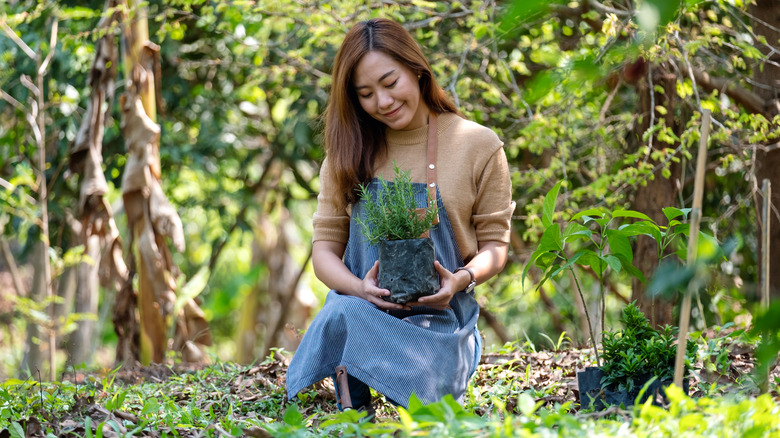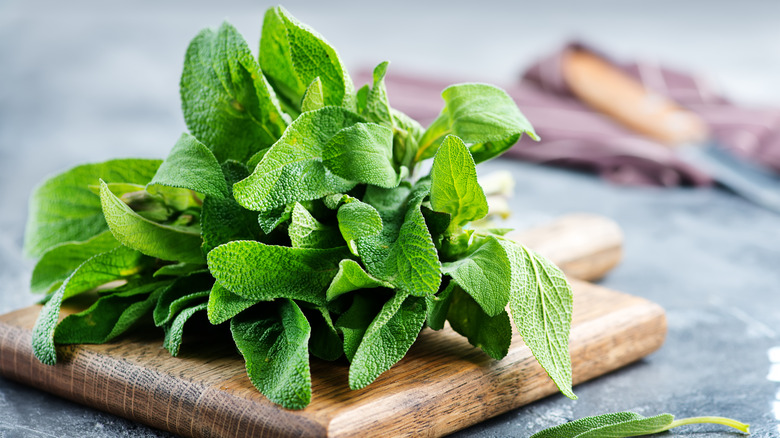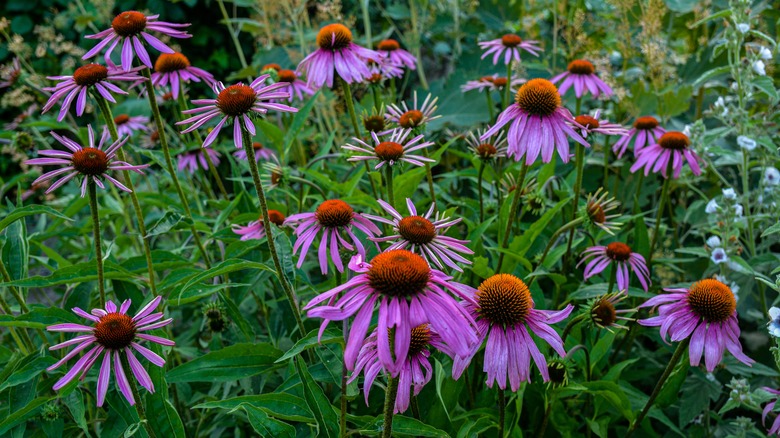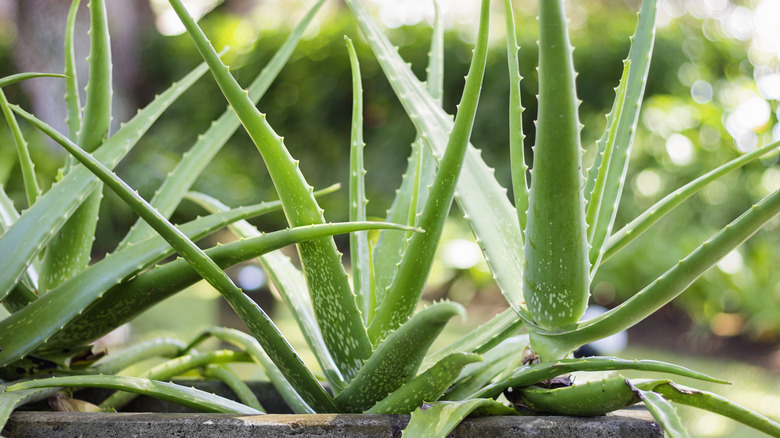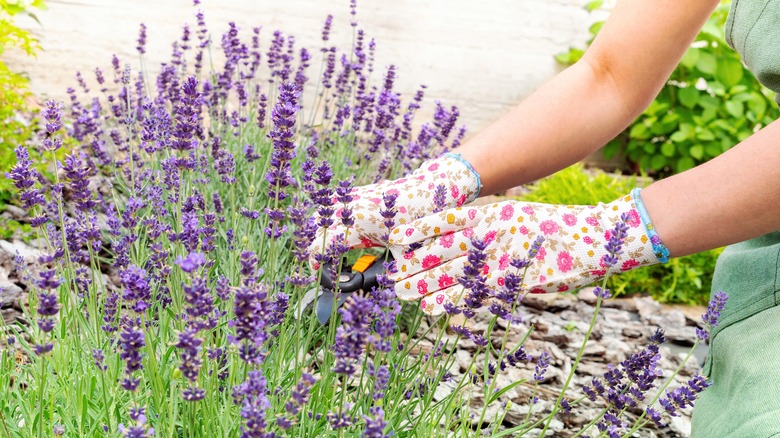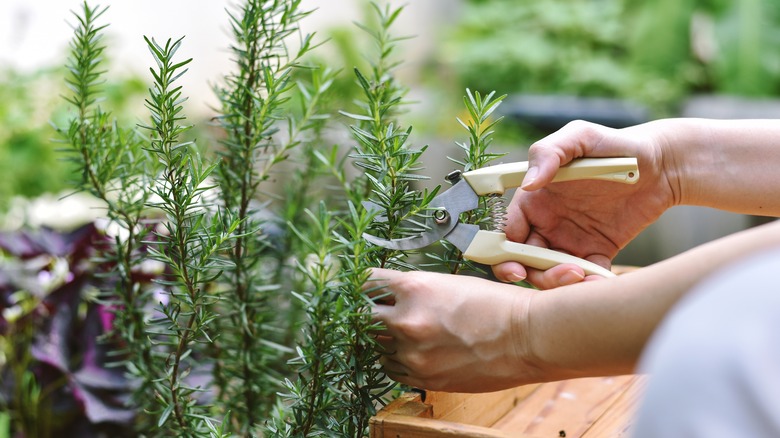The 5 Best Plants For Your Rocky Soil
Does your shovel keep hitting rocks when you try to plant in your garden or yard? If so, you may have rocky topsoil, which can cause a big problem if you choose the wrong herbs or shrubbery. When there are too many rocks, the roots don't have enough room to grow and absorb nutrients, according to MasterClass. However, certain plant life can thrive in this environment because it has a shallow root system and prefers fast-draining soil.
Before planting anything in these rough patches, you need to first condition the soil. Adding organic compost will provide it with nutrients. Now, it's okay not to prepare your garden or yard like this, but you won't be setting up your plants to bloom and thrive. First, rake the area you plan on using. Then, add a 6-inch layer of compost and till the soil. If there are any large rocks, you can remove them. Once you've amended this area, it's time to add the herbs, succulents, and flowers that will work perfectly in the area.
Sage
Sage is an herb that has many different uses. For example, it's often used in cooking to add an earthy and peppery taste to recipes or medicinally to calm an irritated digestive system and as an antiseptic, according to Rural Sprout. It can also cleanse spaces of bad energy. This aromatic herb is perfect for rocky soil because it needs a potting mix that drains well so its roots aren't sitting in water.
Sage prefers full sunlight, but can live in partial shade. Additionally, it needs watering about twice a week as a seedling. Once matured, it only needs to be irrigated every other week. All About Gardening explains that to harvest sage, you can pluck as many leaves from it as needed. However, don't remove more than half of the plant. Pruning is also necessary to encourage new growth, so plan on cutting off 6 to 8 inches from the top of the stems.
Coneflowers
Native to the eastern and central United States, coneflowers resemble daisies that can grow 4 feet high. These beautiful flowers, featuring droopy petals, typically come in two different colors — light purple or burnt orange — and bloom in June and July. After the blooming season, the flowerheads will attract birds like goldfinches to your garden, according to the Missouri Botanical Garden.
If you choose not to amend your yard, coneflowers are ideal as they can live without any nutrients in the soil. However, if you want beautiful blooms, they'll need fertilizer. These flowers require full sunlight, although some afternoon shade will help prevent their petals from fading. Per Almanac, don't water them unless the season has been unusually dry. Coneflowers prefer fast-draining soil, but adding a layer of mulch is beneficial to retain some moisture. In other words, these flowers want the dirt to be damp without their roots sitting in water.
Aloe vera
Aloe vera is a succulent with many uses. When harvested, the gel inside its leaves can aid in relieving skin injuries and conditions, including burns and eczema. It's also helpful for digestive problems, according to the Department of Pharmacology, Pharmacognosy and Botany. Indeed, this invasive species is quite beneficial as its gel is antimicrobial and works as an anti-inflammatory. The leaves are where this plant stores water, making it perfect for adding moisture to your skin.
Since aloe vera is a succulent, it needs a warm climate to survive outside. To that end, it does best in hardiness zones 9 to 11 and can even flower if grown outdoors with plenty of sunlight, according to Gardener's Path. While aloe vera also needs well-draining soil, you should only water it once or twice a month because succulents are like cactuses. A thriving aloe vera plant will also produce little pups around it, which you can separate to become new plants.
Lavender
Lavender is another flowering plant that does well in rocky soil. It's known for its small purple flowers and sweet scent and is often placed in candles and dried for décor. However, it has many other uses, such as helping to eliminate stress, lower high blood pressure, and relieve chronic pain, according to Everyday Health.
Taking care of lavender can be tricky because you don't want to overwater it. While this genus is drought-tolerant and prefers a more arid environment, it should still get watered every two weeks if you want pretty blooms. Indeed, these small purple flowers thrive in rocky soil since they can drain water quickly and don't contain many nutrients, according to Blue Mountain Lavender Farm. So, where's the best place to plant it? Anywhere where there is abundant sunlight.
Finally, harvesting these flowers is essential to promote growth, and lavender tends to bloom in late spring and then again toward the end of summer.
Rosemary
Rosemary is a hardy herb that can withstand rocky soil and is primarily used as a seasoning in food. Serving as an anti-inflammatory and replete with antioxidants, it can also help to improve your immune system and circulation when ingested, according to Medical News Today. Additionally, rosemary is commonly used in cosmetology as a fragrance in soaps or in oils and shampoos to promote hair growth.
If you live in hardiness zones 7 to 10, the best place to plant rosemary is outdoors. When given a chance to thrive, this plant can even produce blue flowers and grow to be 4 feet tall. To properly care for your rosemary, it needs full sunlight, although it will tolerate partial shade. For this plant to grow quickly, it needs 6 to 8 hours of sunlight every day, according to Get Busy Gardening. It also prefers dry soil that will drain quickly. To harvest rosemary sprigs, trim the tender leaves from the tops of their stems. Doing this will also encourage branching and new growth.
